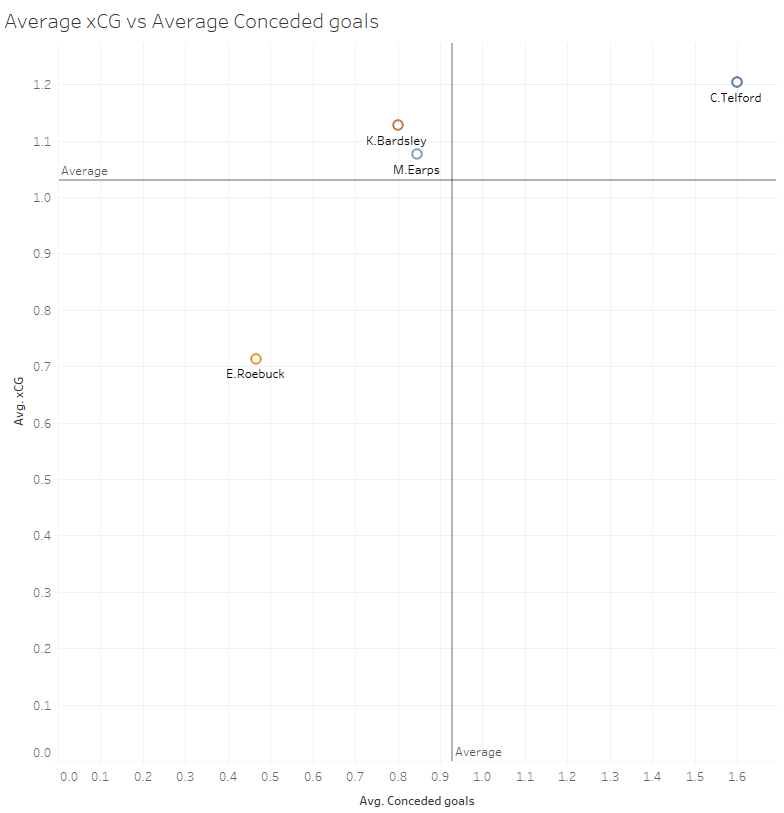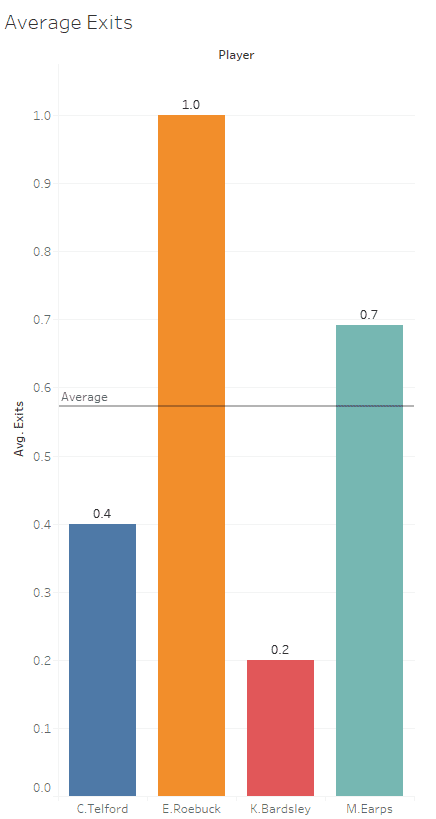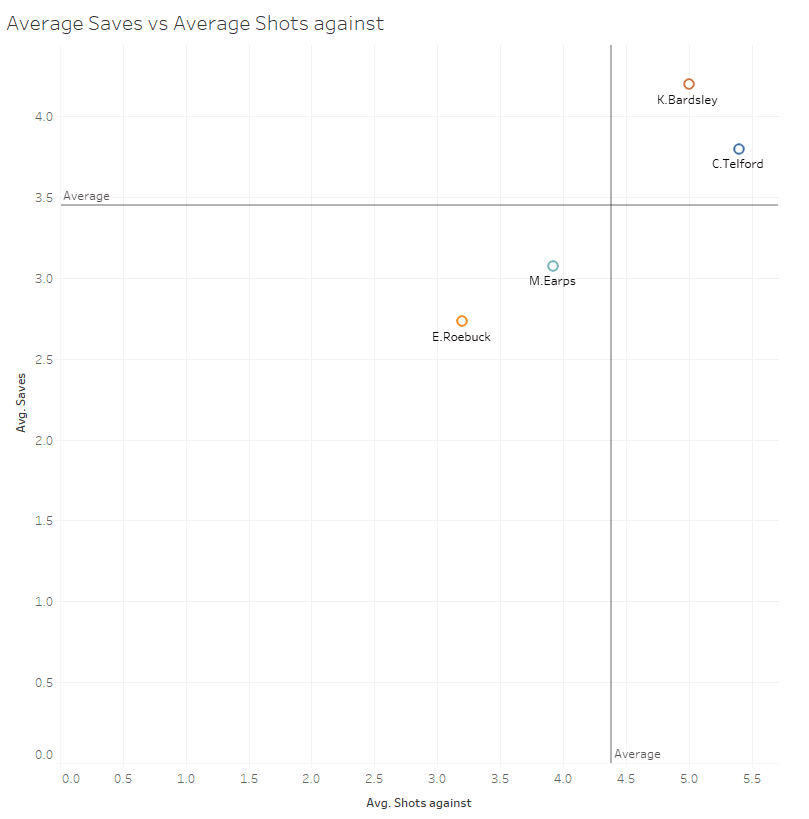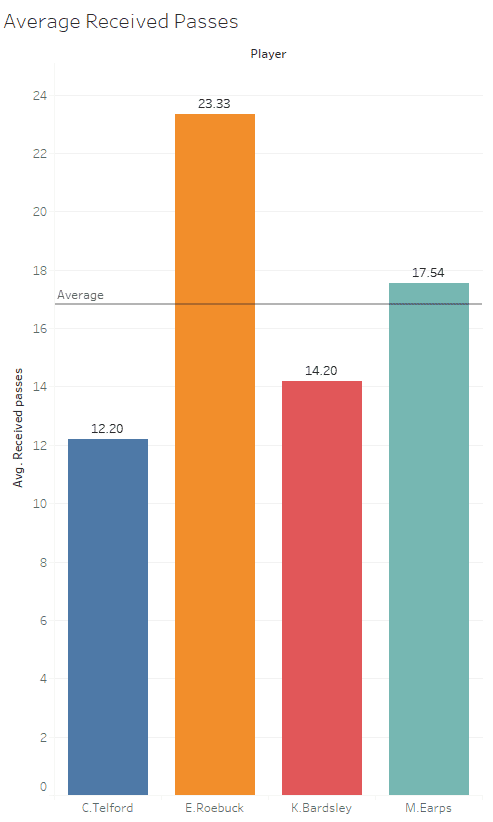This article is a continuation of the data analysis series between Matt Dorman and I on finding Team GB’s 18-person squad using data. With last week’s announcement on the Tokyo Olympics being postponed, we will continue this series to find the squad that could have flown to Japan to compete. Each article will be split by position, and alongside Matt Dorman, the wide forwards, wide defenders, and central defenders have been completed previously. This analysis will look at the data on the goalkeepers and find the statistically best two goalkeepers. Through data analysis, we will examine and analyse the different players in each position to see which players should be picked as part of the 18-player squad.
To remind everyone Matt Dorman and I have applied a few key parameters to keep the overall analysis consistent and fair. The 18-player squad will consist of: two goalkeepers, three full-backs, three central defenders, two holding midfielders, three attacking midfielders, three wide forwards or wingers, and two strikers. We will assume Neville will utilise the 4-2-3-1 system he applies with the Lionesses, where the style of play and tactics revolves around quick interchanges of play with an emphasis on the wide areas for supply and service. Our squad picks have been based on two parameters:
– Players have played 450+ minutes this season
– Currently, playing in the top tier of their domestic leagues.
Using the prerequisites above, the players we have chosen to be part of this data analysis are Ellie Roebuck (Manchester City Women), Carly Telford (Chelsea Women), and Mary Earps (Manchester United Women). To improve the sample size and comparison data, I will be including the 2018/19 data of goalkeeper Karen Bardsley. The Manchester City backup goalkeeper has yet to register any meaningful minutes so far this campaign and thus cannot be considered for final selection. However, being a core fundamental part of England’s World Cup squad in 2018, it makes sense to include her data to see how the others stack up against her.
What kind of goalkeeper are we looking for?
Part of the objective of this data analysis is to find the most suited goalkeepers that should be part of Team GB’s squad. After analysing footage of the Lionesses recent games at the She Believes Cup, I noticed a few key factors that will help us decide the type of goalkeeper needed.
- Sweeper keeper: The chosen goalkeeper will need to be able to play a sweeper-keeper role proficiently. This is because England’s defensive line prefer to sit slightly higher and try to dominate the ball with their adept ball-playing centre-backs and technically proficient midfielders. Many a time the opposition will look to play passes over the top and get in behind leaving the keeper to anticipate expertly.
- Commanding Presence: A few of the goals the team have conceded have come off the back of set-pieces where at times the defence were to blame for the goal. However, there were moments where the goalkeeper could have come out to claim some of these deliveries with more conviction or better timing.
- 1v1 battles: As I’ve mentioned, with England’s backline slightly higher, this inevitably invites opportunities when the goalkeeper will be left in a 1v1 situation against an opposition striker meaning their ability to control and manoeuvre the trajectory of the striker and close off shooting angles will be a key metric in making saves.
- Shot Stopping: Some teams will look to take shots from the edge of the penalty area or closer in the box which will require good reflexes and anticipation.
What metrics are we using?
The following data metrics will be used to try to find the different attributes from the above section. We have derived that we need a sweeper-keeper that has a mixture of shot-stopping and command of their area, which means they are able to come flying off their line to claim crosses and set-pieces. Being able to judge when to come out in 1v1 situations especially in counter-attacks is vital.
To start with, we will look at conceded goals vs Expected conceded goals (xCG). This will tell us how many goals the goalkeepers concede as against the expected goals conceded per 90 minutes. While this gives us an image of the goalkeeper it could also be attributed to the defence in front of them. We won’t be using this as a core statistic but rather a supporting element to see how the player has been performing this season.
To find the best shot-stopper, we’ll be looking at the number shots saved versus the number shots against per 90 minutes. The conversion will give us a better indication of the goalkeepers’ shot-stopping ability and let us know how agile and reactive they are to shots on goal.
Another important aspect of the type of goalkeeper we need is their command of the area and ability to come off their line to claim crosses and deliveries from set-pieces. For this we will be looking at exits. This will help determine their capabilities as sweeper-keepers and if they are able to claim balls that are crossed in.
Lastly, we need to look at the goalkeepers’ distribution and how successful they are. We want to look received passes to understand how much the goalkeeper is used as part of the build-up.
Average Conceded goals vs Expected conceded goals (xCG)

This graph details the number of goals conceded vs the number of Expected goals the players would concede. While we will not be using this metric to determine the best goalkeeper, it is useful when attempting to understand which goalkeepers are conceding more than they should. From there, were can conduct further analysis to see whether this is a goalkeeping or defending problem. The graph is split into four quadrants, where the bottom left quadrant signifies the best performing keeper in terms of the number of goals they concede vs their xCG. At first glance, we can see one outlier in Roebuck who averages 0.46 conceded goals and 0.71 xCG. Telford, on the other hand, averages the highest of the four goalkeepers with an average conceded goals of 1.6 and an average xCG of 1.2. Bardsley averages 0.80 conceded goals and has an average xCG of 1.1. Lastly, Earps averages 0.84 conceded goals as against an average xCG of 1.07.
Exits

Next, we are looking at the average number of exits per 90 minutes. Part of the skillset England goalkeepers require is the command of their area and being able to come and claim crosses. Through video analysis, we have seen that a lot of teams use set-pieces to score against the Lionesses. There are times and situations where better movement from the goalkeeper could have prevented the goal. Telford averages 0.4 exits per 90 minutes and in the middle of the pack with Roebuck averaging the highest of the four goalkeepers with 1.0 exits per 90 minutes. Bardsley averages the lowest at 0.2 and Earps the second highest with 0.7 per 90 minutes.
Average Saves vs Averages shots against

In this section, we are going to examine the number of shots goalkeepers are having to save vs the number of shots they face per 90 minutes. This metric gives us an indication of their shot-stopping abilities and a measure of how they can cope against an onslaught. Teams like the United States Women’s National Team are known for their relentless pressure through their mobile attacking line in Tobin Heath, Megan Rapinoe, and Alex Morgan/Carli Lloyd. Given this, it is imperative to find a good shot shopping goalkeeper.
Looking at this graph, we can see that the four goalkeepers are split between two quadrants. It’s easy to see that Telford and Bardsley have higher averages than Earps and Roebuck. Telford averages 3.8 saves for the 5.4 shots against. Bardsley averages 4.2 saves for every 5.0 shots against which is quite a good ratio for saves to shots against. On the other hand, Roebuck averages 2.7 saves and 3.2 shots against. To round it off, Earps averages 3.0 saves and 3.9 shots against.
Received Passes

This metric will help us understand how much the defence uses the goalkeeper as part of their system. Usually, in recycling possession, centre-backs will use their goalkeepers as part of the build-up process and are important in inviting the opposition to press and open up space in midfield.
Here we can see that only two of the four goalkeepers are above the average line for received passes. Both Roebuck and Earps average high with 23.33 and 17.54 received passes. Telford averages the lowest average number of received passes in 12.20 and Bardsley 14.20.
Recommendation
Based on the above metrics it’s safe to say that all four goalkeepers have their own traits and specialities. It’s been interesting to see how the three goalkeepers have performed this season against England’s number at the World Cup last season. When we observe the results, it seems as though Roebuck is the clear winner in terms of being the first-choice goalkeeper based on the statistics and data we’ve analysed in the article. The Manchester City Women goalkeeper is used to playing with a defence that sits slightly higher and can potentially replicate her abilities there for England. Being in situations where she needs to be wary of passes over her defence can translate across to the national side. She is a talented and young goalkeeper with her whole career ahead of her and seems to average high on the metrics we’ve used above. Earps has come in close second and should be considered as the second goalkeeper that should have made the squad.





Comments